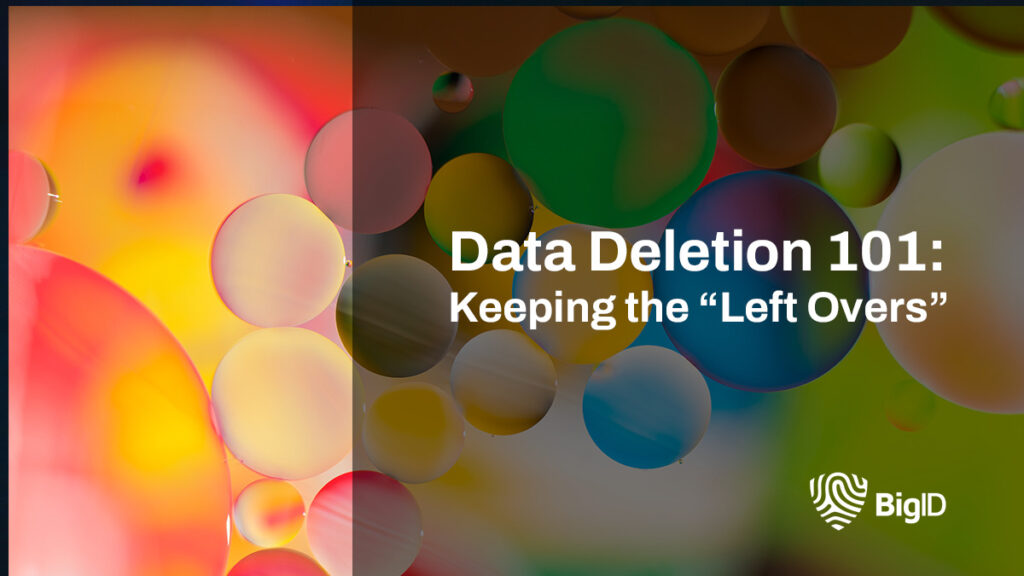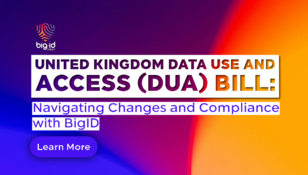Data Deletion 101: Keeping the “Left Overs”

The haunting HBO hit the Leftovers, a global event, caused 2% of the world’s population to disappear. Similarly, regarding data privacy, the General Data Protection Regulation (GDPR) was a global event focused on the disappearance of “data.”
Since GDPR, the deletion of data has become a universal requirement in which organizations must adhere to data deletion requests, data minimization practices, and retention policies. Essentially, the ” Left-Over ” data will keep organizations in compliance.
The Challenges with Data Deletion
Organizations face rigorous requirements for collecting, managing, protecting, and deleting data. Data deletion fulfillment requires ongoing precision, insight, and context to distinguish how data is processed across the organization.
Here are a few of the challenges that make data deletion difficult:
- Data Discovery & Mapping: Without operationalizing data discovery, finding, classifying, and aligning data to identity across all systems is a monumental task. Data mapping allows organizations to document internal and external data processing activities to develop an accurate, reliable data inventory covering all data types.
- Deletion Workflows & Audits: It’s incredibly complex to develop a deletion workflow with a validation process in which data owners can review, approve and confirm the deletion of data. The benefit of consistent deletion workflows is that they provide a comprehensive audit trail to assure compliance with particular regulatory requirements.
- End-to-End Deletion: Beyond developing a strategy and workflow, taking it one step further, many organizations lack automated tools for complete deletion to remove data by system and users.
- Time & Resources: Without proper insight into the data that needs to be erased, data deletion processes can consume an enterprise’s time, resources, and money.
- Constant Validation – It’s also hard to determine on an ongoing basis whether data stayed deleted after receiving a deletion request from specific individuals.
Data Privacy Drives Data Deletion Standards
The Right to Be Deleted
Amongst all the data rights that exist for consumers — like the right to access, the right to correct, etc. — the most complex is the personal right to request data to be deleted across all systems. Additionally, most new regulations require data to be deleted at the end of a contract or agreement and when consent no longer exists. These all apply to the “right to be forgotten,” also commonly known as the “right to erasure.”
Managing Deletion Requests
Regarding the management of deletion requests, most regulations require businesses to provide consumers with multiple methods for submitting requests. The most acceptable submission methods include a link or web form on the business website, a toll-free phone number, a specific email address, in-person submission, and mail-in submissions.
Responding to Deletion Request
- Timing: Not all, but many privacy regulations require businesses to confirm receipt of a deletion request within a specified time (commonly ten business days of receiving the request) and must respond to requests to delete within 30-45 calendar days.
- Notifications: When a business deletes personal information upon a consumer’s request, it must notify the consumer of the completion of the request to delete. In addition, some regulations require a business to notify all third parties that share personal information of the request to delete.
Data Minimization
The EU’s GDPR Article 5 sets the standard for data minimization principles – and other requirements for how companies collect and process personal data, including purpose limitation, accuracy, storage limitation, and confidentiality. The UK’s Information Commissioners Office’s (ICO) data minimization principle states that the personal data collected by any organization needs to be “adequate, relevant, and limited to what is necessary for the purposes for which they are processed.”
The regulations put pressure on businesses to only keep information that has a legitimate purpose. However, data minimization is also about removing duplicate and obsolete data. As a result, data deletion policies tied to data minimization practices can reduce cost and risk significantly.
Data Retention Policies
Data privacy and protection regulations like GDPR and CCPA have established guidelines on the length of time an organization should keep the data it collects, maintains, and processes. Once data is no longer useful, it’s in the organization’s best interest to discard the data to remove potential privacy concerns.
It should be a priority to build data retention policies across the enterprise to align with complex business rules and growing regulations. Businesses’ retention programs also need to account for retention periods, data owners, authority to delete data — and what remediation actions are taken to rectify violations.
Deleting Data Benefits the Business
When a business successfully applies data deletion policies, the key is to uphold deletion requests and remove unnecessary data. Doing so has several benefits:
- Data value depreciates rapidly over time
- The consequence of data breaches is often brand reputation — which is a hard road to recovery
- Staying compliant with deletion policies minimizes the potential for huge fines
- Eliminating data reduces the overall cost of storing all that data
- Increase productivity as resources aren’t used to rerun unnecessary data creating more labor for the system and employees.
Establishing and maintaining data deletion practices is essential for organizations’ data privacy, protection, and compliance measures.
For privacy, limiting the collection of data and deletion:
- protects individuals’ personal privacy
- keeps data fresh and up-to-date, improving its quality and value to the company
- enables companies to maintain regulatory compliance — and more.
For security, deleting data:
- allows businesses to clean up duplicate, similar, and redundant information that likely poses a security risk
- reduce the company’s attack surface — or its number of vulnerable touchpoints in the event of a breach
- lower storage costs — and more.
How BigID Helps with Data Deletion
With BigID, organizations can manage, delegate, and execute deletion requests to fulfill data rights management, accelerate minimization initiatives and enforce retention policies.
Organizations can leverage the BigID Deletion app for end-to-end automated data deletion — and delete within seconds.
- Quickly and easily fulfill data deletion requests by users and application
- Delete data in seconds – across MySQL/MSSQL, google drive, snowflake, oracle, S3, and more
- Validate deletion requests through collaboration and audit trails
- Implement data minimization strategies by purging ROT (Redundant, Obsolete, Trivial) data
- Execute data retention policies to delete on-time
- Automate data retention rules such as legal hold to prevent deletion
- Reduce attack surface and mitigate privacy risk
To learn more about how BigID can help effectively delete data to meet several privacy regulation requirements, set up a 1:1 demo with us to see it in action.













